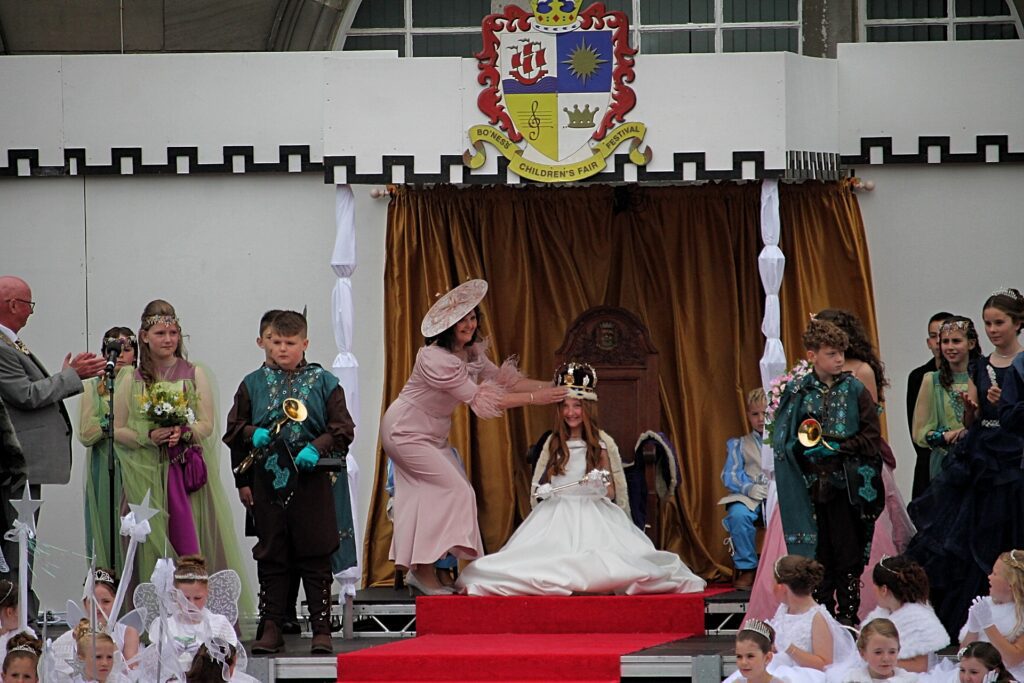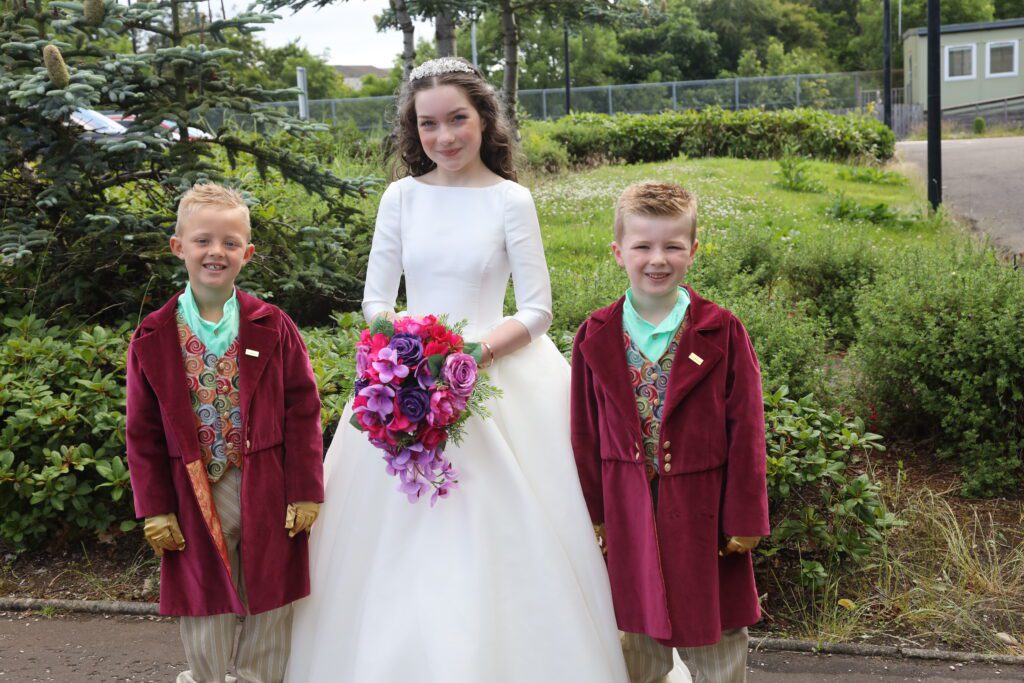“Underneath the arches” – to most people these words recall Flannagan and Allan, but for generations of Bo’nessians they have a much more localised meaning recalling as they do the excitement and anticipation of countless Fair E’ens gone by.
For arches, both large and small, have been a part of Bo’ness Fair almost since its inception in 1897 to mark the diamond Jubilee of Queen Victoria’s reign, with the first street spanning arch being erected seventy years ago in 1905. It was built by the miners who lived in the Snab Rows and among the moving spirits responsible for it were the late Tam Brodie and Mr. Charlie Young, who now lives in Maidenpark. Weeks of work went into the construction of the huge wooden frame but it was completed and decked all over in greenery in ample time to be hoisted into position over the Bo’ness to Grangemouth Road at the foot of the Dean Brae for the Fair on the first Friday after the second Tuesday in July.
The Snab arch, with its three flags fluttering proudly on high, created considerable interest among the townsfolk and the following year miners from many of the other rows in the town took up the challenge. Thus began the rivalry which still flourishes in the annual arch building competition.
Whether the modern arches are as beautifully made as they were half a century and more ago is something which is often argued, the main lament of the traditionalists being the disappearance of the boxwood arches, but it is interesting to note that the original greenery arches were not finished with boxwood at all but with fir branches. It was not until 1910 that boxwood was used for the first time and then not on an arch but on one of the decorated horse drawn vehicles. It belonged to well known butcher Sandy Rankine whose shop was in South Street still thrives as a butchers, now owned by former Bo’ness United Captain, Any McBlain. Each year Mr Rankine entrusted the decoration of his pony and trap to Mr Alex. Heath, one of whose friends was Kinneil estate employee John Bell, and it was he who first suggested that clipped boxwood would provide a much neater finish. Together the two men went along the Dean and cut a pile of boxwood with which the little butcher’s cart was duly decorated. The result must have been impressive, because from then on boxwood became the accepted greenery not only for the decorated floats but for the arches as well.
One of those who had a hand in the construction of more of these traditional green boxwood arches that he now cares to remember was Mr Heath’s son Bobby, who, although he now insists that he has retired from active arch building in fact almost changed the whole of Bobby Heath’s life as he recalled for me as we sat in his Maidenpark home, surrounded by photographs of the scores of arches, large and small, which he masterminded.
“The big arch I remember most was the one I helped to build for Queen Bessie Cowie outside the old Kinneil School at Deanfield in 1928. That was the year I was married and almost divorced”, he added with a twinkle in his eye as he glanced across at his wife.
“That must have been the wettest Fair week ever and even on the Fair E’en it was still bucketing down. All the lads had made a tremendous effort to build the town’s first ever double span arch, but as it continued to splash down their spirits sagged and there was talk of abandoning it and never getting if off the ground. At 8 o’clock it was still lying there, when suddenly it dried up and I persuaded them that, even if we never put on one single decoration, at least we should hoist it into position.”
“Despite the sodden greenery we managed it, and when I shinned up to the top to help secure it, there over the Ochils was one glint of Sunshine in that grey leaden sky. I knew that meant a fine Fair after all and I hadn’t the heart to leave that beauty without a single rose so I worked on through the night. By 4 o’clock we were almost finished when I discovered we had not ferns to decorate the base of the columns. Wee Willie Buchanan volunteered to get some from the ravine above the Dean Burn, but we thought he was never coming back. When he did he was drookit from head to foot for he had lost his grip on the slippery slope and plunged into the burn itself, which was swollen with all the rain of the previous week. He had got the ferns, however, so I stayed on just a wee while longer to fix them on.”
“There wasn’t much of the night left when I finally got home after 6 o’clock, and you can imagine the row from my young bride, especially when I told her that I had to be out again by half past to help Mr. White, the undertaker, put up the decorations in the Glebe Park.”
That new bride of 47 years ago certainly learnt to live with her husband’s other love for arches, for now she recalls how, even when they enjoyed a Saturday night out during the weeks before the Fair, the crepe paper went too so that no time was lost making the thousands of paper roses needed for his prize creations.
The use of paper roses, papier mache, stone effect wallpaper and all the other modern aids to arch building are, of course, a reminder to the ever-increasing difficulty of finding adequate supplies of boxwood. This Mr. Heath claims dates back to 1930 when a particularly large arch was erected at Richmond Cross Roads for Queen Kathleen Jamieson. George Clark, Balfour Patton and George Snedden are some of the names which Mr. Heath recalls in connection with monster arch, 60 feet wide and 33 feet high, which spanned Linlithgow Road and which robbed Kinneil Woods of all its boxwood.
From then on arch builders had to go as far away as Perth to ensure sufficient supplies and although large green arches did continue into the years after the Second World War with a particularly fine one erected at Cadzow Avenue for Queen Mary Sneddon in 1947, the days of the traditional arch were clearly numbered when the first of the turreted castle style arches was successfully built across Philpingstone Road in 1951, the year Grange School pupil Margaret Henderson was Queen.
Like most old-timers Mr. Heath has his reservations about the use of modern materials in arch building, but to find out what today’s judges look for in the annual competition, I asked local artist Guthrie Pollock, who accompanied by John Cannon and Mr F. R. S. Marr from Edinburgh, spends most of each Fair morning performing “Simplicity of design, novelty value and good finish all count,” Mr Pollock told, me. “When we drive up on the Fair morning an arch often looks good from a distance but when we look more carefully and go round the back, it is often less impressive,” he continued.
As an art teacher Mr. Pollock admits that he also looks for good colour and prefers decoration to be under, rather than overdone.
“There is a terrible temptation to put on everything but the kitchen sink,” he added. “and especially on small arches this can be disastrous. At the other end of the scale some arches now have scarcely any decor at all as they rely so much on special lighting effects, which look wonderful by night, but which are difficult to judge when we see them in daylight in the morning.”
Mr Pollock also feels that the layout of many of the newer areas of the town makes it difficult to give the small arches as much appearance as they deserve as they are so often hidden away round corners and in cul-de-sacs, which makes it difficult even for judges to find them.
But find them Mr Pollock and his fellow judges will, when they set out on their rounds on Friday, 27th June, in the hope of finding more masterpieces like Bobby Heath’s “Sine Metu” sailing ship arch of a number of years ago and last year’s much talked about “Wild West Saloon”, which continue to make the Bo’ness Fair arches unique in the whole country and which makes it so worthwhile to go out “underneath the arches” on the Fair E’en.
UNKNOWN






